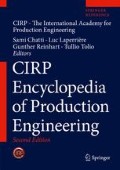Access this chapter
Tax calculation will be finalised at checkout
Purchases are for personal use only
References
Dewhurst P (1978) On the non-uniqueness of the machining process. Proc Roy Soc Lond A 360:587–610
Fang XD, Jawahir IS (1996) An analytical model for cyclic chip formation in 2-D machining with chip breaking. Ann CIRP 45(1):53–58
Fang N, Jawahir IS (2002) An analytical predictive model and experimental validation for machining with grooved tools incorporating the effects of strains, strain-rates and temperatures. Ann CIRP 51(1):83–86
Fang N, Jawahir IS, Oxley PLB (2001) A universal slip-line field model with non-unique solutions for machining with curled chip formation and a restricted contact tool. Int J Mech Sci 43(2):557–580
Ganapathy BK, Jawahir IS (1998) Modeling the chip-work contact force for chip breaking in orthogonal machining with a flat-faced tool. J Manuf Sci Eng 120(1):49–56
Ghosh R, Lin M, Fei J, Jawahir IS, Khetan RP, Bandyopadhyay P (1995) A new feature-based chip-groove classification system for chip breakability assessment in finish turning. In: ASME WAM, San Francisco, Nov 1995, pp 679–701
Ghosh R, Dillon OW Jr, Jawahir IS (1998) An investigation of 3-D chip curl in machining – part 1: a mechanics-based analytical model. J Mach Sci Technol 2(1):91–116
Hagiwara M, Chen S, Jawahir IS (2009) Contour finish turning operations with coated grooved tools: optimization of machining performance. J Mater Process Technol 209(1):332–342
Jawahir IS (1986) An theoretical and experimental study of the effects of tool restricted contact on chip breaking. PhD thesis. University of New South Wales, Sydney
Jawahir IS (1990) On the controllability of chip breaking cycles and modes of chip breaking in metal machining. Ann CIRP 39(1):47–51
Jawahir IS, Fang XD (1995) A knowledge-based approach for designing effective grooved chip breakers – 2D and 3D chip flow, chip curl and chip breaking. Int J Adv Manuf Tech 10:225–239
Jawahir IS, van Luttervelt CA (1993) Recent developments in chip control research and applications. Ann CIRP 42(2):659–693
Jawahir IS, Balaji AK, Rouch KE, Baker JR (2000) Towards integration of hybrid models for optimized machining performance in intelligent manufacturing systems. In: Proceedings of IMCC, Hong Kong
Johnson W (1962) Some slip-line fields for swaging or expanding, indenting, extruding and machining for tools with curved dies. Int J Mech Sci 4:323–347
Kluft W, Konig W, van Luttervelt CA, Nakayama K, Pekelharing AJ (1979) Present knowledge of chip control. Ann CIRP 28(2):441–455
Kudo H (1965) Some new slip-line solutions for two-dimensional steady-state machining. Int J Mech Sci 7:43–52
Lee EH, Shaffer BW (1951) The theory of plasticity applied to a problem of machining. J Appl Mech 18:405–413
Lin M, Da ZJ, Jawahir IS (1998) Development and implementation of rule-base algorithms in CAPP systems for predicting chip breakability in machining. In: ICME 98, CIRP international seminar on intelligent computation in manufacturing engineering, 1–3 July, Capri, pp 517–522
Merchant ME (1944) Basic mechanics of metal cutting process. J Appl Mech 11:A168–A175
Nakayama K (1962) Chip curl in metal cutting process. Bull Fac Eng Yokohama Natl Univ 11:1–13
Nakayama K (1984) Chip control in metal cutting. Bull Jpn Soc Precis Eng 18(2):97–103
Nakayama K, Ogawa M (1978) Basic rules on the form of chip in metal cutting. Ann CIRP 27:17–21
Oxley PLB (1989) Mechanics of machining: an analytical approach to assessing machinability. Ellis Horwood, Chichester
Sandvik (1996) Modern metal cutting: a practical handbook. Sandvik Coromant, Fair Lawn
Shi T, Ramalingam S (1993) Modeling chip formation with grooved tools. Int J Mech Sci 35(9):741–756
Spaans C (1971) The fundamentals of three-dimensional chip curl, chip breaking and chip control. Doctoral dissertation. Department of Mechanical Engineering, TU Delft, Netherlands
Usui E, Hoshi K (1963) Slip-line fields in metal machining which involve centered fans. In: Proceedings of the international production engineering research conference ASME, Pittsburgh, pp 61–71
Wang X, Jawahir IS (2002) Prediction of tool-chip interface friction and chip-groove effects in machining with restricted contact grooved tools using the universal slip-line model. Key Eng Mater 233–236:469–476
Wang X, Jawahir IS (2007) Recent advances in plasticity applications in metal machining: slip-line models for machining with rounded cutting edge restricted contact grooved tools. Int J Mach Mach Mater 2(1):347–360
Wang L, Saito K, Jawahir IS (1996) Infrared temperature measurement of curled chip formation in metal machining. Trans NAMRI XXIV:87–92
Author information
Authors and Affiliations
Corresponding author
Editor information
Editors and Affiliations
Section Editor information
Rights and permissions
Copyright information
© 2019 CIRP
About this entry
Cite this entry
Jawahir, I.S. (2019). Chip-Forms, Chip Breakability, and Chip Control. In: Chatti, S., Laperrière, L., Reinhart, G., Tolio, T. (eds) CIRP Encyclopedia of Production Engineering. Springer, Berlin, Heidelberg. https://doi.org/10.1007/978-3-662-53120-4_6394
Download citation
DOI: https://doi.org/10.1007/978-3-662-53120-4_6394
Published:
Publisher Name: Springer, Berlin, Heidelberg
Print ISBN: 978-3-662-53119-8
Online ISBN: 978-3-662-53120-4
eBook Packages: EngineeringReference Module Computer Science and Engineering

